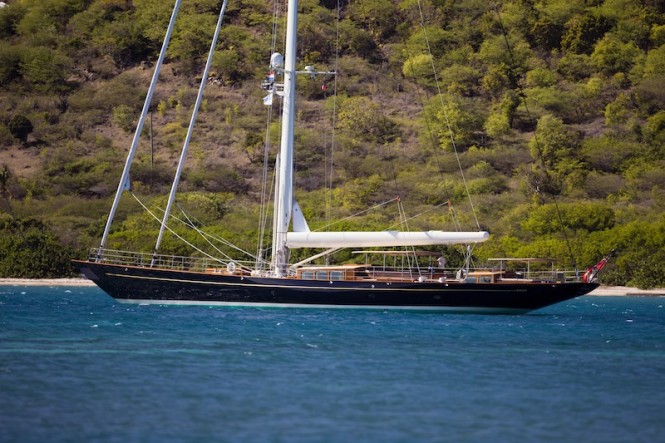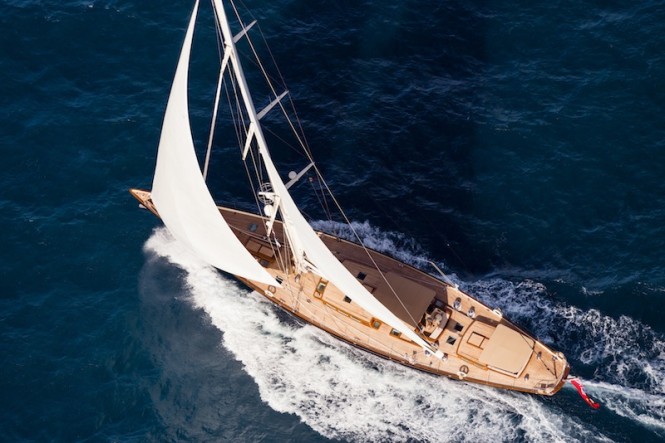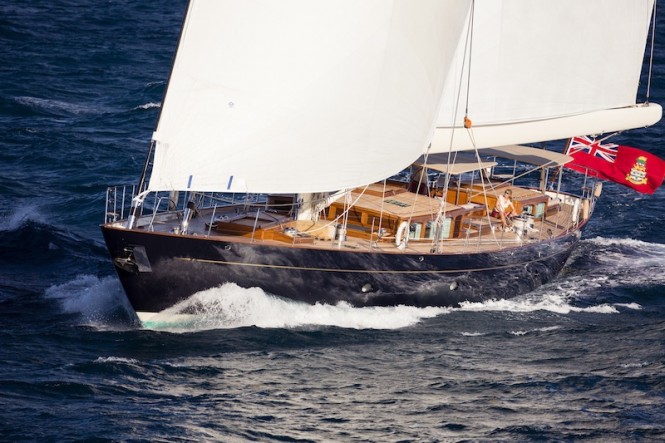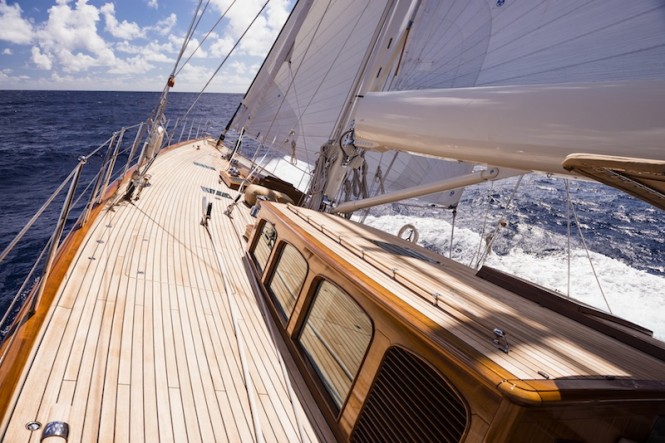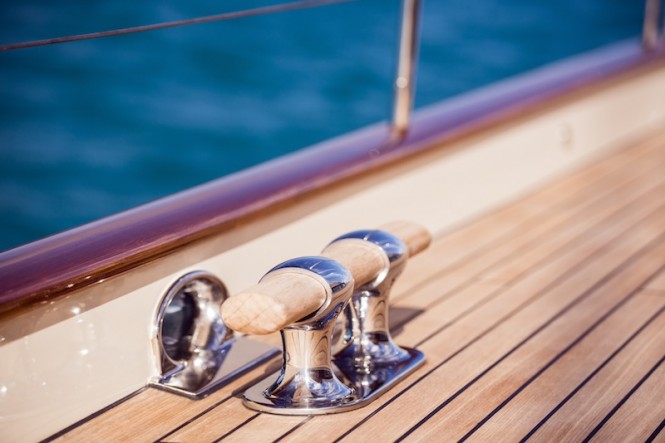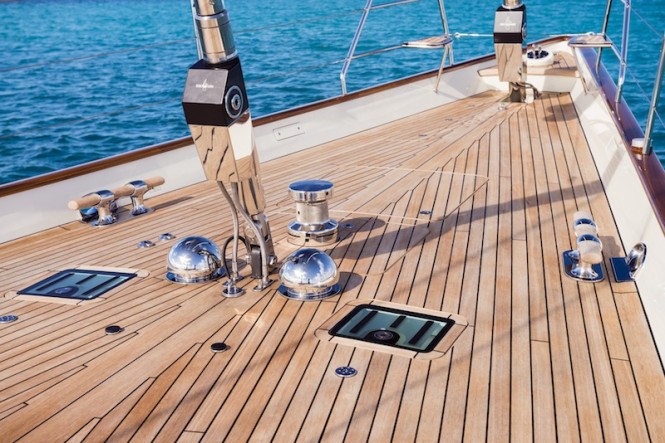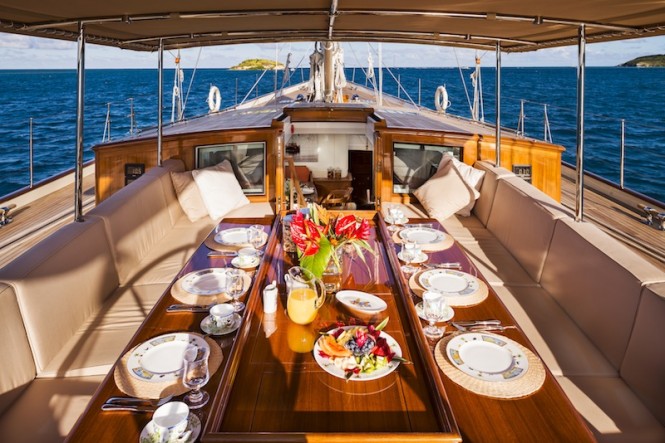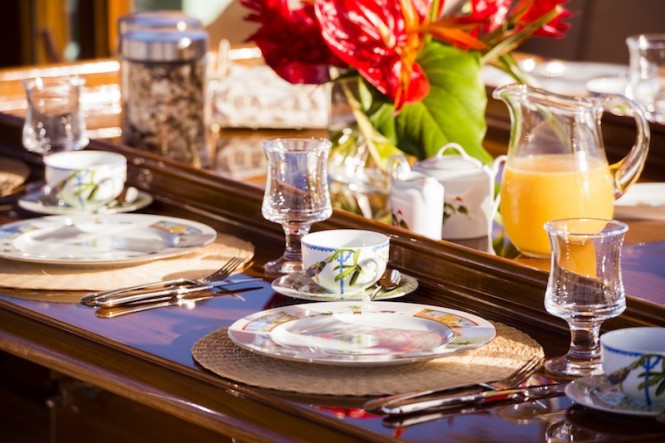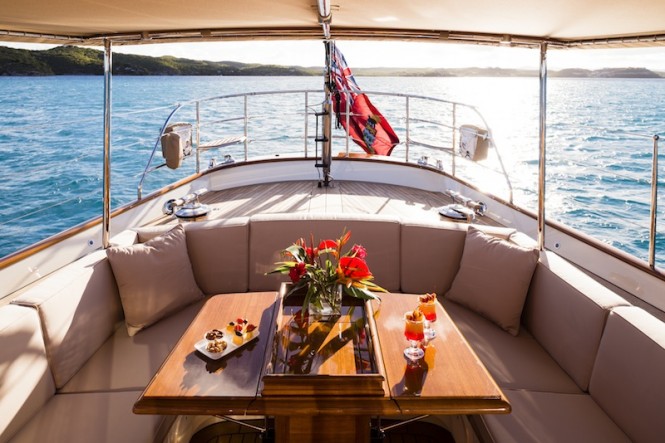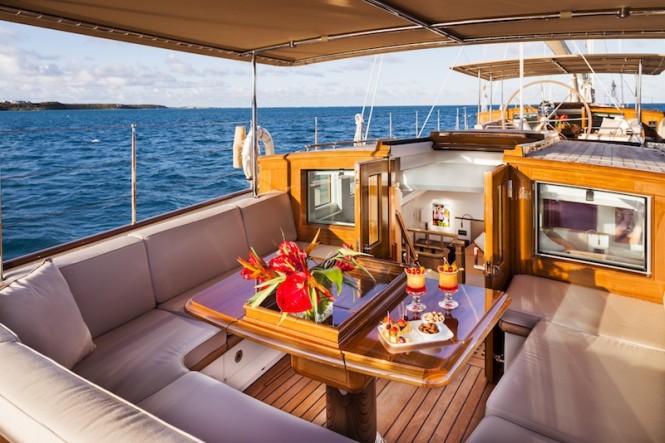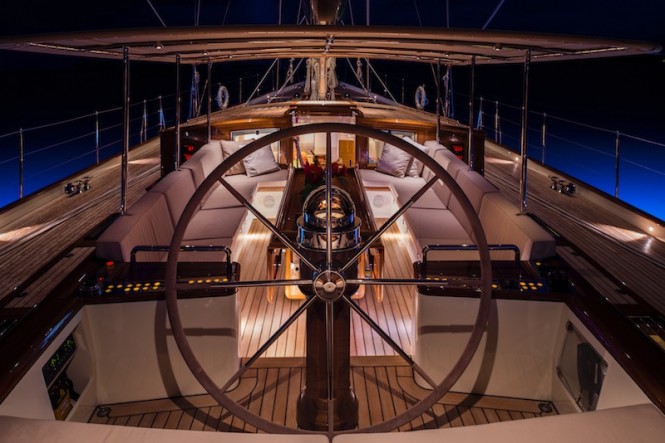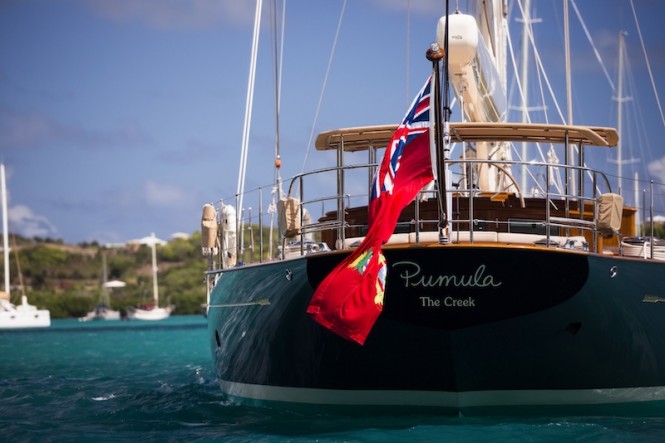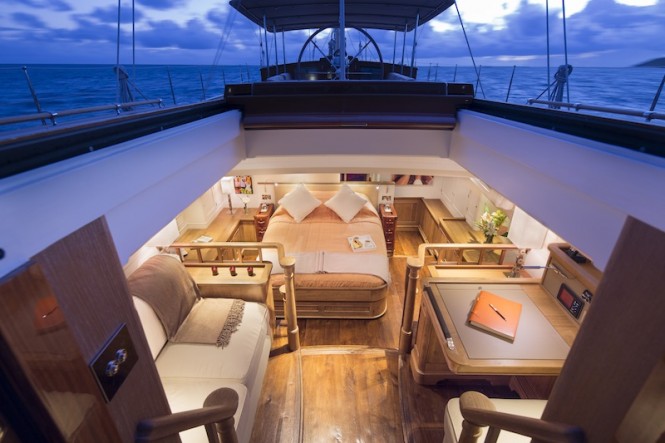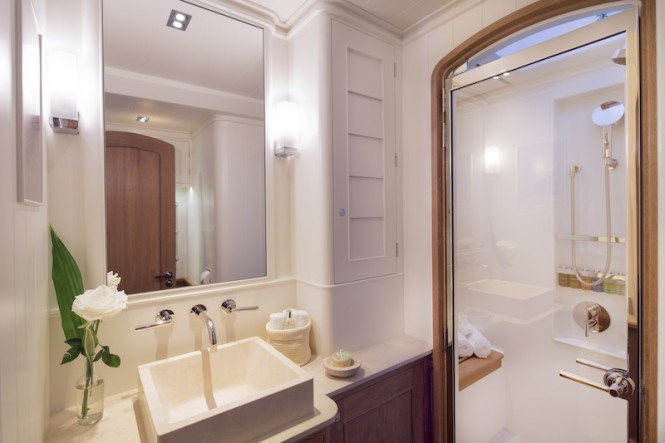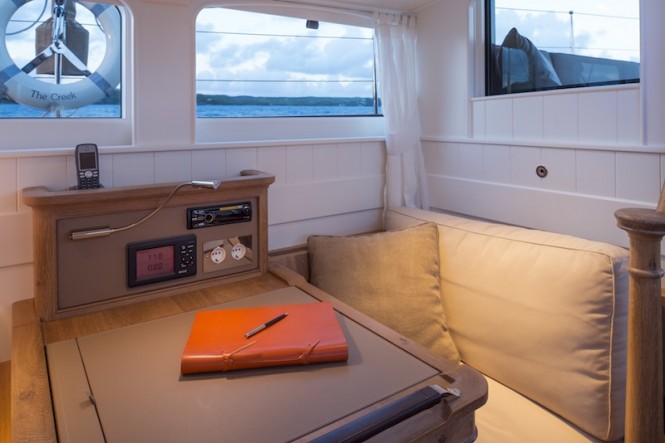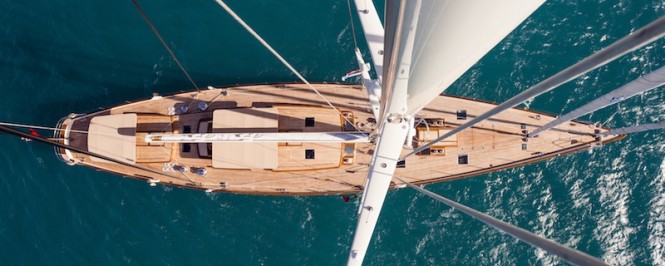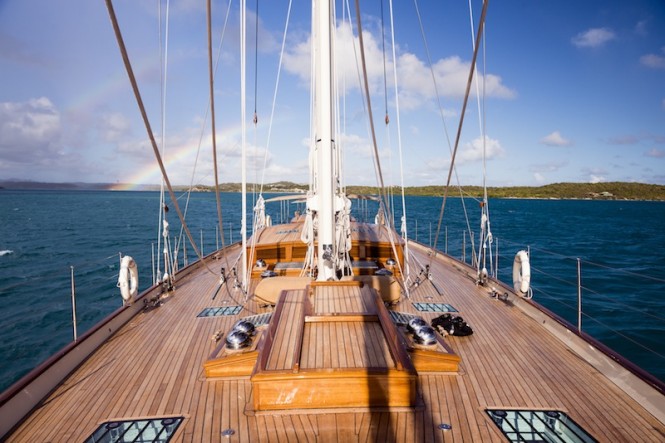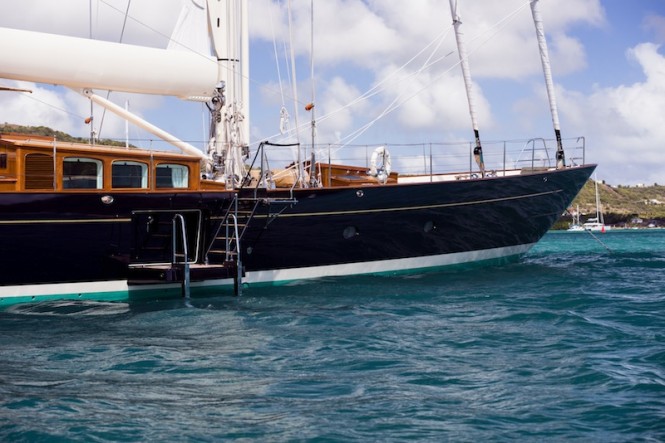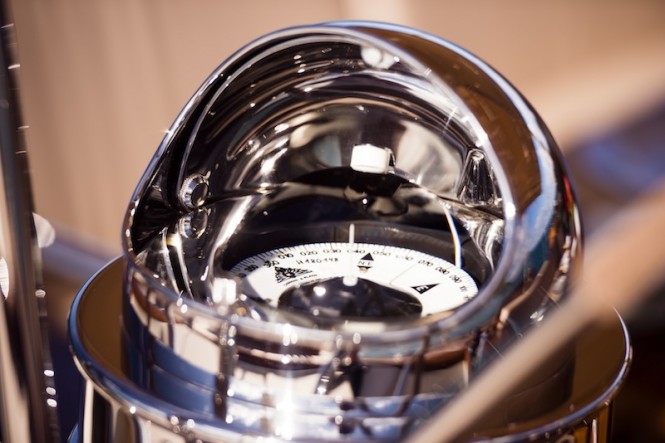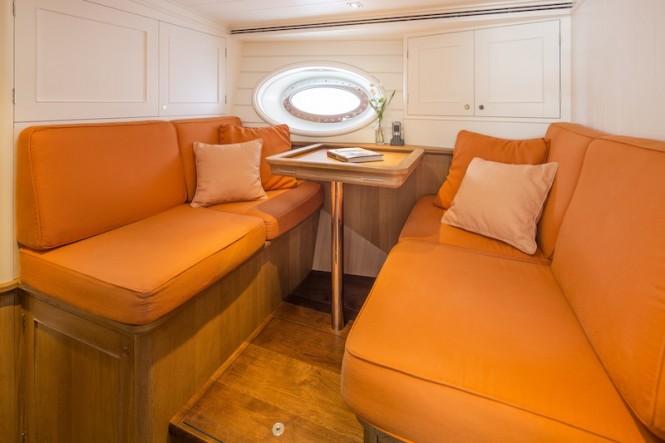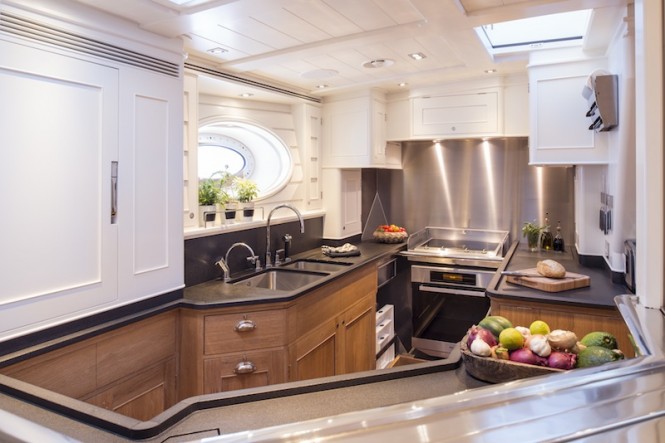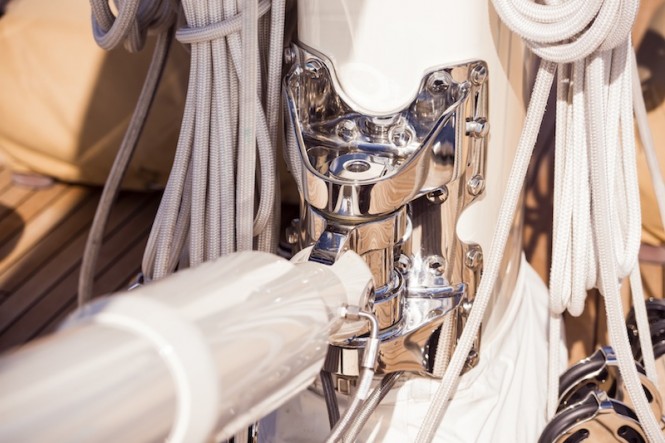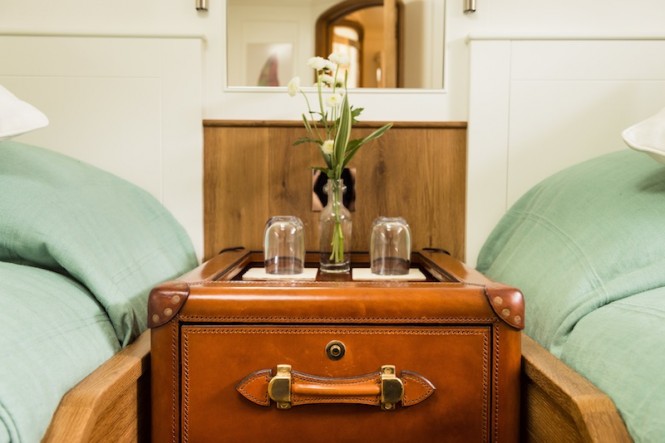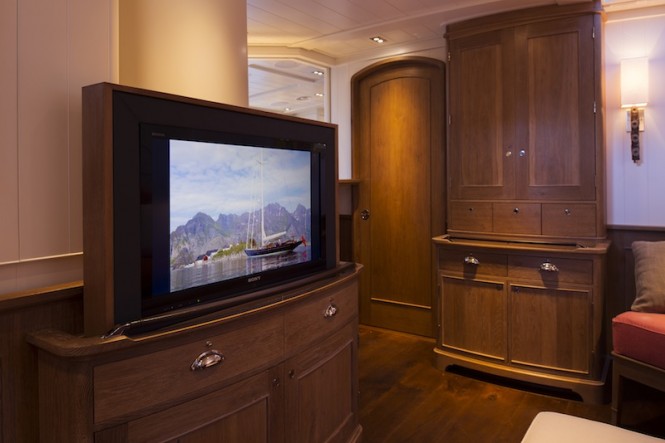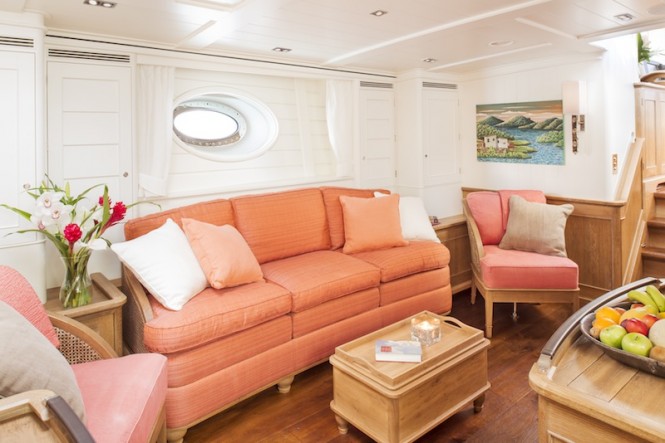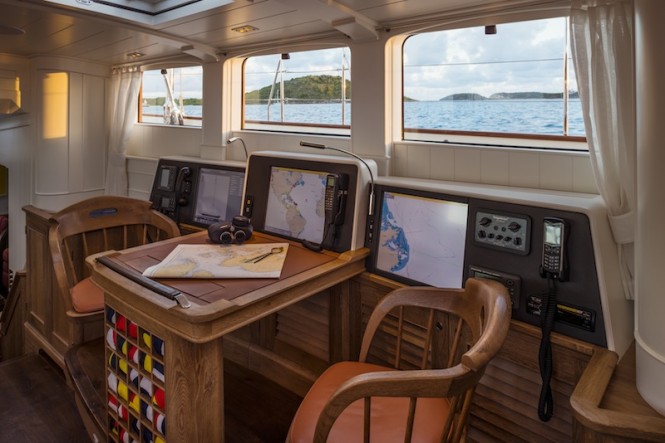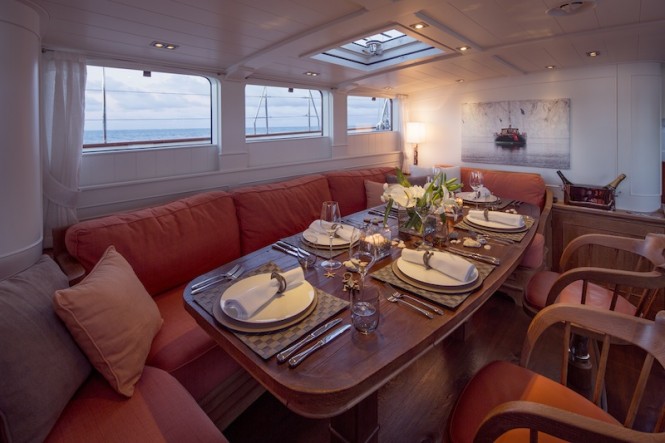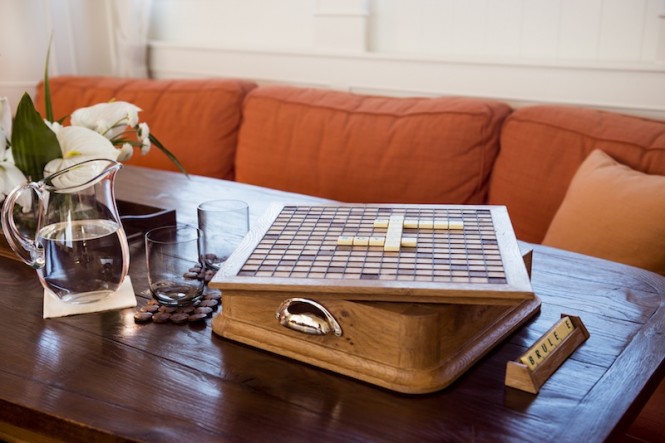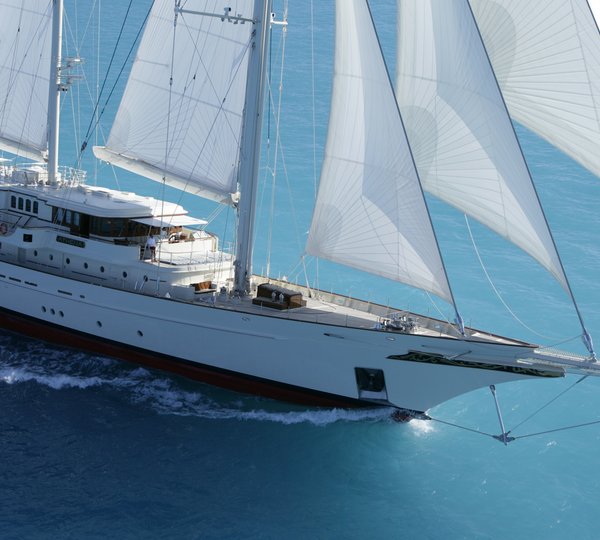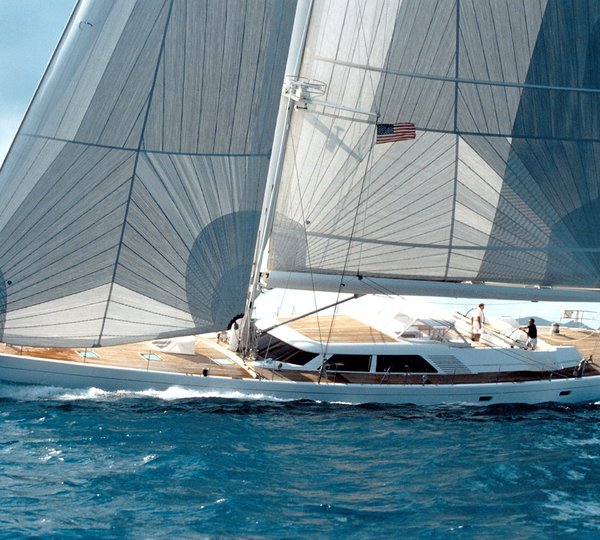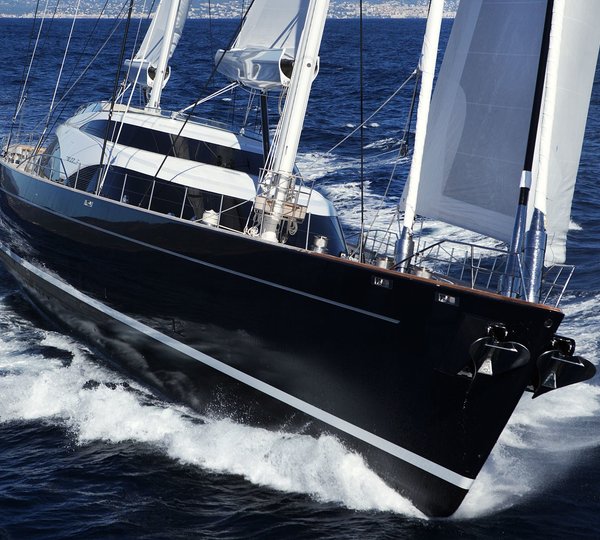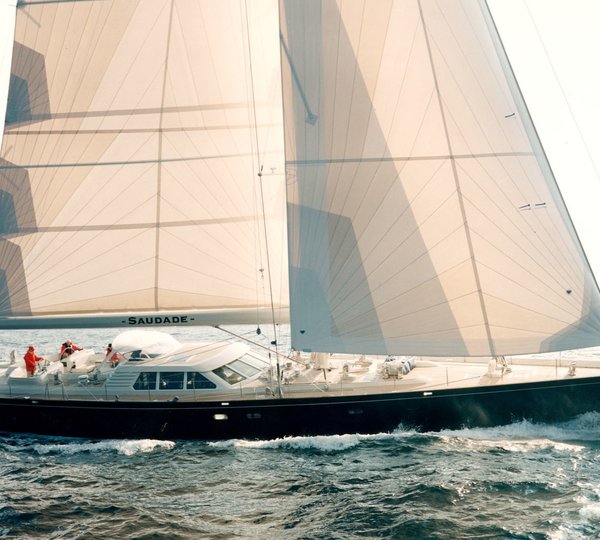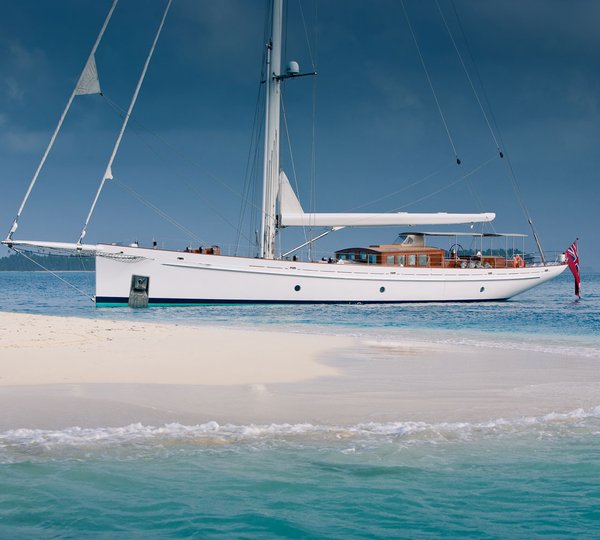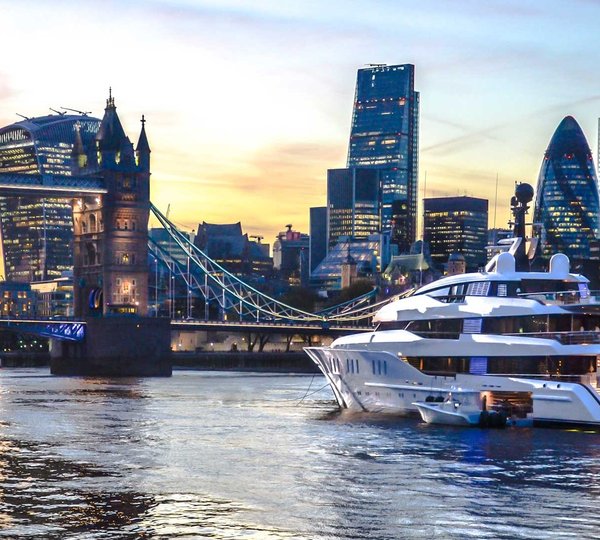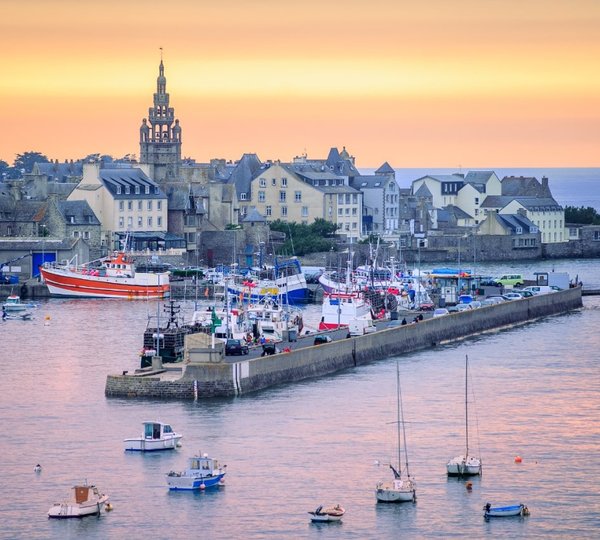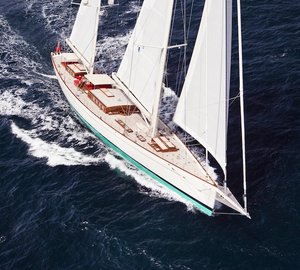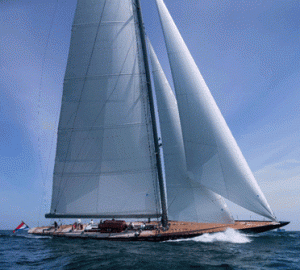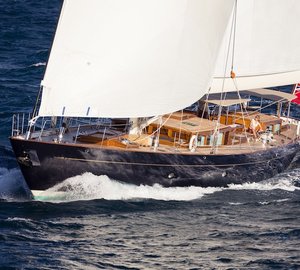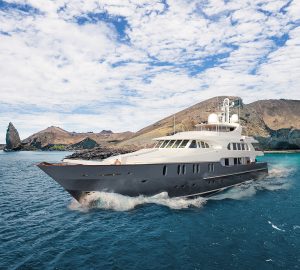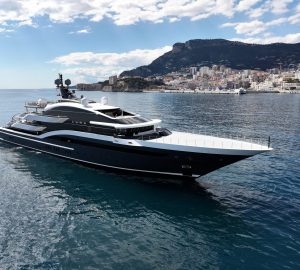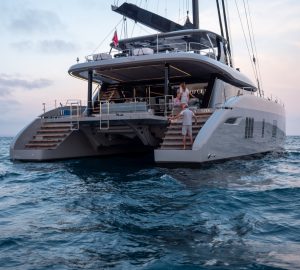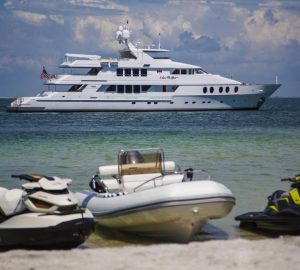For yachting enthusiasts that appreciate ‘true yachts’, sailing yacht PUMULA (Project Bugamena) is more than a pleasure to sail. Following her delivery by Royal Huisman in Spring 2012, luxury superyacht PUMULA ventured off on a summer cruise in Norway and Spitsbergen and spend the winter months cruising the Caribbean; two extremes and almost 12,000 nautical miles within one year after her delivery.
Imagine a classic yacht that captures the spirit of adventure so perfectly, it might really have been built for adventurous souls of an earlier era.
Imagine the seamanlike attention to detail: the sheer line, the layout and handling, the true feel of the rudder on the helm, the secure cockpit and comfortable sea berths, the wonderful ambiance below decks.
Then imagine a yacht with a tall carbon rig and powerful sail plan working in harmony with a fully ballasted and retractable bulb keel for excellent light or heavy weather performance and sea keeping, on or off the wind. A yacht whose stunning classic looks give little indication of the carefully selected technologies that enhance comfort and lifestyle, safety and reliability, communications and navigation, ease of operation by a small crew.
Put the two together and you have a singular yacht: the 37.33m/122.5ft cutter rigged sloop Pumula – an orchestrated blend of tradition and modernity.
The vision defines the yacht
Pumula superyacht is an admirable rarity in these days of ever-increasing size and complexity in superyachts. Her owners have great respect for the honesty and simplicity of yachts built in the classic era and sought to create a beautiful and luxurious, yet technologically straightforward and uncomplicated yacht.
Such a yacht would be large enough to cruise the world, high latitudes and low, in comfort with family or friends, yet small enough to be easily handled by a small crew and by the owners themselves. The result is undoubtedly stunning.
The commitment of the owners to the purity of the aesthetic and to relative simplicity can be seen in numerous individual features. Like all modern yachts, Pumula enjoys the advantages of modern navigation technologies but, unlike most, there is no visual intrusion of screens and readers around the helm; they are only visible when required. The helm itself is a single, central wheel – twin wheels would hardly be right. Pumula has state of the art communications, yet they are complemented by SSB radio, as this is still a valuable and enjoyable tool for the committed long distance sailor.
These examples of the owner’s philosophy were sympathetically interpreted by the talented team at Dykstra Naval Architects to create a beautifully understated yacht that “looks right and sails right”. From the fine curve of her bow through the sensitive sheer of her hull to the elegant transom stern, Pumula looks every inch the classic.
The low profile teak-clad deckhouses and well-proportioned cockpit coamings give balance to her lines while the soaring off-white mast and rollaway boom add a clear sense of purpose. There are no plans for regatta sailing Pumula – she is a long distance cruising yacht – and, to this end, Dykstra Naval Architects have designed an efficient under-body with a fully-ballasted and retractable bulb keel extending to 5m/16ft for maximum windward traction and lifting to 3m/10ft for access to shoal draft anchorages. Her deep semi-spade rudder is constructed from aluminium.
A fresh interpretation
Interior designers Rhoades Young have succeeded in creating an environment below decks that is evocative of an earlier era yet offers a fresh, light and stimulating interpretation rather than a formal homage. A theme of bleached oak joinery, finished to emphasise the texture of the grain and the figuring of the wood, contrasts with darker oak flooring and white-painted panelling and deck-heads to create an intimate, almost contemporary styling. The patina of the wood has been developed through highly skilled wax-based finishing techniques that make the light oak, for example, appear aged and polished through usage. There are a numerous imaginative design features including saddle stitched leather-bound bedside tables, inspired by suitcases from the golden age of cruise liners, that accentuate the warmth and charm of the cabins. Stepping down into the main deck house from the cockpit, one encounters a wonderfully light and airy space, thanks to large windows on three sides, skylight hatches overhead and extensive white painted panelling. To port, a stylish oak dining table, hand-stained to match the oak flooring, seats eight guests while, to starboard, there is informal seating either side of a table that conceals a navigation station.
A few steps forward and down lead to the lower salon – a relaxed area for socialising that features comfortable seating and entertainment facilities to starboard and a breakfast counter/ cocktail bar to port. The bar counter, attractively finished in pewter, is an extension of the open-plan galley, giving added amenity and extended eye lines; it can also be closed off to the salon, when desired, with a sliding fire-proof screen. A door beside the bar provides access to a multi-purpose double cabin that can be used either by guests or by a local pilot when sailing in remote regions.
Returning to the main deckhouse, stairs aft lead to the principle owner and guest accommodation where beautifully fitted twin cabins are situated to port and starboard with the owner’s full-beam suite aft. All guest cabins enjoy the benefit of natural light through elegant oval portholes in the hull as well as light and air from overhead skylights.
The owners’ suite includes a master bed on the centerline with views aft through the owners’ deckhouse, a small office, and attractively curved steps leading to sheltered and secluded casual seating area within the aft deckhouse itself. This seating adapts simply into a small couch, should the owner choose to relax or sleep there.
Meticulous craftsmanship
On deck, the fine attention to detail is evidenced by margin-free hatches giving the appearance of continuous planking, and by painstakingly crafted polished steel and teak cleats precisely positioned to take the feeds from custom engineered fairleads. Pumula yacht’s anchor is securely stowed and conveniently launched from a neat recess in the port bow, ensuring a clear, uncluttered foredeck. In the centre of the foredeck area, just aft of the tender stowage, a teak-finished cuddy provides access to the crew quarters.
The main deckhouse has a classic low profile enhanced by three lightly-arched windows on either side and finished in varnished and natural teak. To maximize air flow capacity the subtle “teak” ventilation louvers on the forward face of the deckhouse (as elsewhere on this yacht) are in fact constructed from capacity giving carbon fibre with a fine teak veneer for strength and weight saving. Either side of the coach roof, teak grab rails with polished steel fittings are designed and engineered in visual harmony with the deck cleats.
Immediately aft of the main deckhouse, the principle cockpit features comfortable, secure seating around a dining table incorporating refrigerated storage facilities. The helm station and its bench seat are situated at the aft end of the cockpit, providing both a social and a practical link with the cockpit area and the deckhouse.
The wheel is mounted on a fine varnished teak pedestal surmounted by a traditional binnacle compass. To port and to starboard, operational controls are subtly incorporated into the cockpit infrastructure. Helm station display screens are neatly concealed within the same units, designed to glide smoothly upwards into view when in operational mode.
The smaller, aft deckhouse forms part of the owners’ suite and gives onto a secluded private cockpit with its own table, also with refrigerated storage, and seating.
Crew quarters
Sailing Yacht Pumula does not require a large crew but her owner has gone to some lengths to provide high quality accommodation for them. Forward of the lower deck salon (and accessible from either the salon or the foredeck) the crew quarters include a welllit and comfortable crew mess with good natural light and luxurious double and twin crew cabins, each with ensuite bathroom. The captain’s cabin includes a Pullman berth for maximum flexibility of accommodation.
The galley is well-lit, neatly laid out for the practicalities of cooking at sea, and comprehensively equipped. Everything is fitted out to the highest professional standards. Opposite the crew mess, stairs lead to the crew entrance on deck, while service to the lower deck salon is conveniently delivered via the open plan galley counter and adjoining door.
Handling Pumula
The Pumula project team – her owners, their designers, project manager Jens Cornelsen, and the yard team – have taken infinite pains with every operational detail of this yacht. The large sail plan of 784m2 is designed to ensure good light air performance, yet easily handled by two people thanks to sail management systems that include captive winches for the main sheet and halyard, hydraulic boom furling, and furling headsails.
The helmsman enjoys excellent all-round visibility, including over the main deckhouse, as well as the reassuring protection of the surrounding coamings. For the committed yachtsman, superyacht Pumula is a pleasure to sail.
Owners’ Statement
Regrettably the owners are unavailable in time for this submission. On their behalf we extrapolate some of their past comments:
“We had a clear and defining vision for Pumula – we wanted a classically inspired design that evoked the honest simplicity of the “gentleman’s sailing yacht” of an earlier era. We wanted to cruise long distances in a yacht that could easily be sailed short-handed; in fact, a yacht that we could sail ourselves with the support of just a small crew. As we were planning an extensive and adventurous cruising itinerary to include the high latitudes we required shoal-draft access to sheltered anchorages, sea-kindly handling in heavy weather, good upwind performance in all conditions and the capability to keep the miles flowing under the keel in light airs. We were keen to avoid a technologically over-complicated yacht, partly for practical reasons and partly for aesthetic reasons. But a luxurious and well-appointed interior with excellent modern amenities does not have to be at odds with that, if well executed; it is a very desirable feature when cruising in remote or extreme weather regions and adds greatly to the ambience and enjoyment when sailing with family and friends. The challenge was to incorporate these amenities in a sympathetic and understated manner.
In summary, we wanted a true “sailor’s yacht” – a boat that looks right and one that sails right. Regarding the looks, we knew that attention to detail in the smallest fixtures, fittings and finishes would be every bit as important as getting the overall lines right. As for the sailing, Pumula has proven to sail just as we dreamed.
We are delighted to have more than fulfilled our vision.”
Naval Architects: Dykstra Naval Architects
“Our watchword, in designing Pumula, was “understatement”. We knew we had to draw a yacht that would be admired for subtle and sensitive interpretation – where all the small details, when taken together, would add up to a compelling result. This aesthetic quality had to be complemented by first class performance, handling, comfort and accommodation – Pumula was not just for show. We drew a classic hull profile with a finely curved bow, sensitive sheer and elegant transom, always keeping in mind the sometimes-opposing demands of accommodation and performance. Low profile, teak-clad deckhouses and carefully-proportioned coamings balance the hull lines, while the tall sloop rig adds a clear sense of purpose. Below the waterline we designed an efficient under-body with a fully-ballasted and retractable bulb keel extending to 5m for windward traction and lifting to 3m for shoal draft anchorage, all complemented by a deep semi spade rudder.
Special attention was given to the design of a rig and sail plan that would meet performance expectations across the polars and all sea conditions, together with sail management systems that would ensure ease of handling by a small crew. On deck we sought simplicity and a sense of authenticity. To meet this objective, this yacht could only have a central wheel rather than twin helms, so careful attention had to be given to the sight lines from the helm over the deck-houses. For short-handed sailing, the sail controls needed to be close at hand for the helmsman – but not obviously so. This philosophy informed every aspect of our work on what has turned out to be a highly successful project.”
Interior design: Rhoades Young Design
“It was refreshing to work with a brief that, on the one hand, sought to reflect traditional craft and design references and, on the other, was open to a more modern interpretation. Our challenge was to integrate the required accommodation into the 90ft waterline length of a very fine performance hull with low freeboard. This led to an extremely efficient layout with maximum integration of services and build. Eye lines and ergonomics were closely studied to maximise views from the deck house. The aft cabin is most unusual with the aft dog house open to the owner’s cabin, separated only by balustrades, allowing the owners to lie in bed and look aft out of the dog house windows. This is a relaxed social space with a dedicated area for the owner to work, with very cleverly hidden screens and monitors.
We introduced numerous design details that express the individuality and involvement of very hands-on owners including a lower saloon that opens to the galley so that the owners can enjoy being with the crew and be an integral part of the running of the yacht. One of the biggest challenges was to develop the patina of the wood. The light oak was to appear as much used and polished; to have a gentle warmth without being precious. We had to search out knots in the wood, rather than omit them, and the finish was hand-applied using stains and tints to fill the wood’s open grain. The result is an old friend – perhaps somewhere where one spent many years holidaying as a child – nostalgic, secure and reassuring.
Leather-bound bedside tables, inspired by suitcases from the golden age of cruise liners, accentuate the warmth of the cabins.
Considerable thought was given to achieving maximum flexibility of the interior layout, just one example being a forward cabin that can be used either for guests, or by additional crew for a delivery passage.”
Builder’s statement: Royal Huisman
“Refreshingly Pumula represents a technologically straightforward build whilst presenting many interesting challenges in meeting the often-competing demands for authenticity of detail, ease of sail handling, scope of accommodation and quality of amenity. For a yacht of her size and long overhangs, Pumula affords excellent accommodation including owners’ suite, two aft guest cabins, forward guest cabin, galley and crew quarters. Common areas offer a deckhouse with dining table and informal seating and a lower salon that even incorporates a bar area. Huisman’s design engineers took great pains to maximise the scale and quality of these spaces whilst sensitively incorporating such necessities as the housing and mechanism for a fully ballasted retractable bulb keel, operational systems, machinery spaces, captive winches being all in accordance with the compulsory regulations of Lloyds / MCA authorities.
On deck, the quest for authenticity and simplicity drove the yard’s approach to every task. An interesting example is the helm display screens which, while essential to the operation and navigation of every modern superyacht, do not fit in with the aesthetic of the classic “gentleman’s yacht”. The answer was to design and engineer screens that rise smoothly into view when required and retract equally smoothly to integrate with the coamings when not required. Deck fittings were meticulously designed, engineered and crafted – for example the deck cleats and grab rails were individually created from teak and highly polished steel. Margin-free deck hatches were carefully planned and joinered to give the appearance of continuous planking. Ventilation louvres were constructed from carbon composite with a fine teak veneer for strength and weight-saving – the list of ‘devil in the details’ is lengthy!
Below decks, the yard carefully executed Rhoades Young’s concept, taking great pains to select the appropriate oak types and samples for furniture and flooring, each of which required specific and highly skilled wax based finishing techniques. Royal Huisman is proud to have contributed to the creation of a boat that might appear, on first acquaintance, to be one more fine classic yacht; but that, on closer inspection, reveals herself to be a gem in every detail.”

